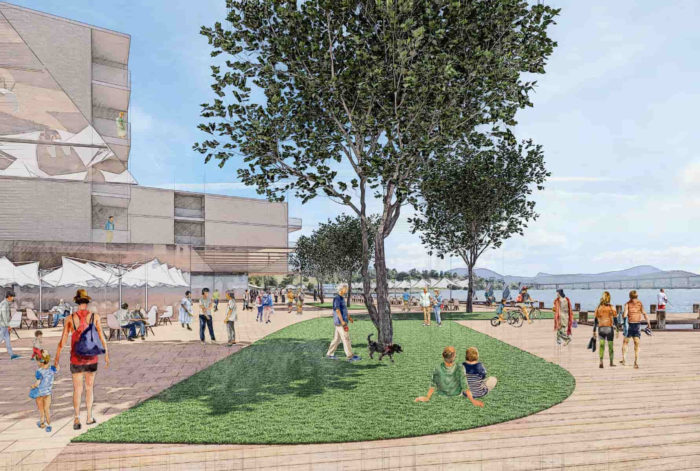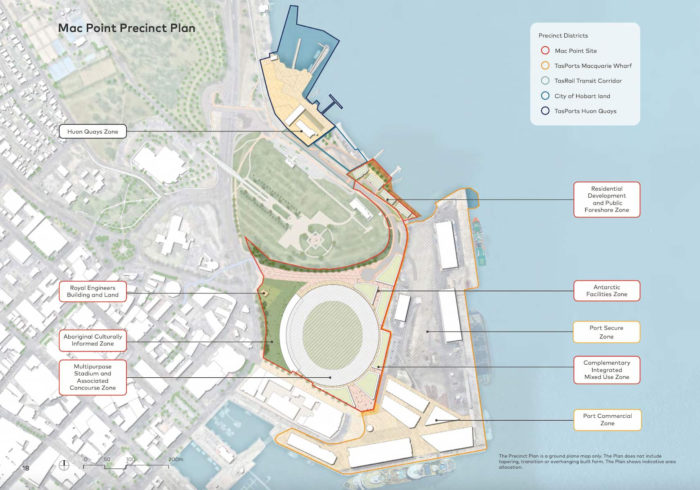The tasmanian government has released a draft precinct plan for the redevelopment of Macquarie Point in Hobart. This plan comes after reviewing over 2,000 written submissions about the development, which is known for its rich heritage.
Macquarie Point, situated between Hobart’s CBD and the Port of Hobart, serves as a connection point for various landmarks and facilities in the city. It links the CBD to the Queen’s Domain, the Hobart Cenotaph, the intercity cycleway, and the Tasman Bridge. Over the years, this site has served multiple purposes, starting as the ancestral land of the muwinina people before being utilized as a farm, abattoir, lumber yard, gas works, cold store, goods storage, and military drill yard.
Creating a Vibrant Community: The Macquarie Point Precinct Plan
The government plans to create a versatile stadium, a culturally significant area for First Nations people, facilities for Antarctic research, a mixed-use zone, residential areas, and a public foreshore at Macquarie Point. The Macquarie Point Development Corporation, in collaboration with Cox Architecture, has developed a draft plan for the precinct.
According to the plans, the goal of the new mixed-use precinct is to create a space for the community and visitors to come together and engage in various activities such as arts, culture, sports, events, and entertainment. The addition of a multipurpose stadium would allow for larger-scale events that are currently not possible in the state. The stadium itself covers an area of approximately 43,000 square meters, excluding the external concourse. To honor the Aboriginal culture, a designated zone is proposed for the northern and western (front) face of the site, taking into account its increased visibility. The design team plans to collaborate with First Nations enterprises to determine the name, purpose, and potential integration of narrative, storytelling, and educational elements in this space.
A proposed Antarctic Facilities Zone, covering 8,000 square meters, is planned north-east of the stadium. This zone aims to support the growth of the Antarctic industry by providing administrative office spaces and an underground carpark for organizations. Priority will be given to those with projects in the Antarctic.
On the other hand, the Mixed-Use Zone, located in the southwest, will act as a connection point between Macquarie Point, the Macquarie Wharf Commercial Zone, and Sullivans Cove. It will offer a variety of commercial, retail, and food and beverage spaces.
On the other hand, the Mixed-Use Zone, located in the southwest, will act as a connection point between Macquarie Point, the Macquarie Wharf Commercial Zone, and Sullivans Cove. It will offer a variety of commercial, retail, and food and beverage spaces.
The plan suggests constructing a residential and foreshore area that includes affordable housing for healthcare workers and apartments for the general market. The residential development will be designed to harmonize with the stepped topography of the foreshore and will have a ground floor that houses commercial, retail, or food and beverage establishments. The zone will have pedestrian walkways that connect to the main activity hub and provide access to communal open spaces, public transport options, and the publicly accessible foreshore.
The Royal Engineers Building, which was established in 1847, will remain at its current location. The Macquarie Wharf and Huon Quays will also remain and undergo upgrade works. The project will be divided into three stages. Stage one will include upgrades to the Macquarie Wharf, northern access road works, and the start of the events stadium. Stage two will involve the development of the residential zone, public foreshore, Aboriginal Culturally Informed Zone, and Commercial Port Zone. The final stage of the project will focus on the Mixed-Use Zone, Antarctic Facilities Zone, and Huon Quays.
The plans for the precinct aim to enhance connections and accessibility to neighboring sites and parks while also preserving the heritage and maintaining the scenic views of the cove. Additionally, the design seeks to integrate the waterfront through the allocation of public spaces along the water’s edge in order to extend Hobart’s urban character.
During the consultation phase, over 2,000 submissions were collected regarding the multipurpose stadium. The responses were mixed, with predominantly strong support but also strong opposition to the development of a stadium on site. Concerns mainly revolved around the venue’s size or a preference for an alternative facility. Most submissions favored the new venue attracting visitors during off-peak travel seasons, but many also expressed a desire for a sensory-informed space that considers all aspects of mobility and accessibility.
The plans for the precinct aim to enhance connections and accessibility to neighboring sites and parks while also preserving the heritage and maintaining the scenic views of the cove. Additionally, the design seeks to integrate the waterfront through the allocation of public spaces along the water’s edge in order to extend Hobart’s urban character.
During the consultation phase, over 2,000 submissions were collected regarding the multipurpose stadium. The responses were mixed, with predominantly strong support but also strong opposition to the development of a stadium on site. Concerns mainly revolved around the venue’s size or a preference for an alternative facility. Most submissions favored the new venue attracting visitors during off-peak travel seasons, but many also expressed a desire for a sensory-informed space that considers all aspects of mobility and accessibility.
The goal of the project is to achieve a Green Star rating by incorporating sustainable design measures that focus on optimizing energy efficiency and minimizing carbon emissions. The draft precinct plan is currently available for public review and feedback. The design team and stakeholders are actively working on the masterplan, which will provide comprehensive information about the different zones and their intended purposes.



